An Evaluation and Region Division Method for Ecosystem Service Supply and Demand Based on Land Use and POI Data
Abstract
:1. Introduction
2. Materials and Methods
2.1. Study Area
2.2. Data
3. Research Methodology
3.1. ESS Evaluation
3.2. ESD Evaluation
3.2.1. Construction Land ESD Equivalent
3.2.2. POI KDE
3.2.3. ESD Evaluation
3.3. Region Division for ESS and ESD
4. Results and Discussion
4.1. ESS
4.2. ESD
4.3. Region Division for ESS and ESD
5. Conclusions
Author Contributions
Funding
Conflicts of Interest
References
- Wang, J.; Lin, Y.F.; Zhai, T.L.; He, T. The role of human activity in decreasing ecologically sound land use in China. Land Degrad. 2018, 29, 446–460. [Google Scholar] [CrossRef]
- Cerretelli, S.; Poggio, L.; Gimona, A.; Yakob, G.; Black, H. Spatial assessment of land degradation through key ecosystem services: The role of globally available data. Sci. Total Environ. 2018, 628, 539–555. [Google Scholar] [CrossRef] [PubMed]
- Arowolo, A.O.; Deng, X.; Olatunji, O.A.; Obayelu, A.E. Assessing changes in the value of ecosystem services in response to land-use/land-cover dynamics in Nigeria. Sci. Total Environ. 2018, 636, 597–609. [Google Scholar] [CrossRef]
- Jing, Y.C.; Chen, L.D.; Sun, R.H. A theoretical research framework for ecological security pattern construction based on ecosystem services supply and demand. Acta Ecol. Sin. 2018, 38, 4121–4131. [Google Scholar]
- Burkhard, B.; Kroll, F.; Nenkov, S.; Muller, F. Mapping ecosystem service supply, demand and budgets. Ecol. Indic. 2012, 21, 17–29. [Google Scholar] [CrossRef]
- Villamagna, A.M.; Angermeier, P.L.; Bennett, E.M. Capacity, pressure, demand and flow: A conceptual framework for analyzing ecosystem service provision and delivery. Ecol. Complex. 2013, 15, 114–121. [Google Scholar] [CrossRef]
- Schrter, M.; Barton, D.N.; Remme, R.P.; Hein, L. Accounting for capacity and flow of ecosystem services: A conceptual model and a case study for Telemark, Norway. Ecol. Indic. 2014, 36, 539–551. [Google Scholar] [CrossRef]
- Ma, L.; Liu, H.; Peng, J.; Wu, J.S. A review of ecosystem services supply and demand. Acta Geogr. Sin. 2017, 72, 1277–1289. [Google Scholar]
- Bai, Y.; Wang, M.; Li, H.; Huang, S.F.; Juha, M.A. Ecosystem service supply and demand: Theory and management application. Acta Ecol. Sin. 2017, 37, 5846–5852. [Google Scholar]
- Gu, K.K.; Yang, Q.Q.; Cheng, F.; Chu, J.L.; Chen, X.H. Spatial differentiation of Anhui Province based on the relationship between supply and demand of ecosystem services. J. Ecol. Rural Environ. 2018, 34, 577–583. [Google Scholar]
- Guan, Q.C.; Hao, J.M.; Ren, G.P. Ecological indexes for the analysis of the spatial–temporal characteristics of ecosystem service supply and demand: A case study of the major grain-producing regions in Quzhou, China. Ecol. Indic. 2020, 108, 105748. [Google Scholar] [CrossRef]
- Peng, J.; Yang, Y.; Xie, P.; Liu, Y.X. Zoning for the construction of green space ecological networks in Guangdong Province based on the supply and demand of ecosystem services. Acta Ecol. Sin. 2017, 37, 4562–4572. [Google Scholar]
- Burkhard, B.; Kandziora, M.; Hou, Y.; Müller, F. Ecosystem service potential, flows and demands–concepts for spatial localization, indication and quantification. Landcs. Online 2014, 34, 1–32. [Google Scholar] [CrossRef]
- Gao, S.; Janowicz, K.; Couclelis, H. Extracting urban functional regions from points of interest and human activities on location-based social networks. Trans. GIS 2017, 21, 446–467. [Google Scholar] [CrossRef]
- Han, H.; Yu, X.; Long, Y. Identifying urban functional zones using bus smart card data and points of interest in Beijing. City Plan. Rev. 2016, 40, 52–60. [Google Scholar]
- Lin, Q.; Sun, F.; Wang, X.M.; Liao, C.; Zhang, W.X. Hierarchical system of Beijing commercial center judged from POI data. J. Beijing Norm. Univ. (Nat. Sci.) 2019, 55, 415–424, (In Chinese with English abstract). [Google Scholar]
- Hao, F.L.; Wang, S.J.; Feng, Z.X.; Yu, T.T.; Ma, L. Spatial pattern and its industrial distribution of commercial space in Changchun based on POI data. Geogr. Res. 2018, 37, 366–378. [Google Scholar]
- Dong, R.C.; Jiang, T.Q.; Li, H.H.; Li, S.Y.; Zhang, Y.L.; Fu, X. Service radii analysis of green space based on electronic navigation map POI in Beijing urban area. Acta Ecol. Sin. 2018, 38, 8536–8543, (In Chinese with English abstract). [Google Scholar]
- Yan, Y.; Zhu, J.Y.; Wu, G.; Zhan, Y.J. Review and prospective applications of demand, supply, and consumption of ecosystem services. Acta Ecol. Sin. 2017, 37, 2489–2496. [Google Scholar]
- Ling, H.; Yan, J.; Xu, H.; Guo, B.; Zhang, Q. Estimates of shifts in ecosystem service values due to changes in key factors in the Manas River basin, northwest China. Sci. Total Environ 2019, 659, 177–187. [Google Scholar] [CrossRef]
- Liu, G.Y.; Yang, Q. Non-monetary accounting on ecosystem services valuation: Theory and methodology. Chin. J. Environ. Manag. 2018, 10, 10–20. [Google Scholar]
- Martín-López, B.; Gómez-Baggethun, E.; García-Llorente, M.; Montes, C. Trade-offs across value-domains in ecosystem services assessment. Ecol. Indic. 2014, 37, 220–228. [Google Scholar] [CrossRef]
- Costanza, R.; d’Arge, R.; De Groot, R.; Farber, S.; Grasso, M.; Hannon, B.; Limburg, K.; Naeem, S.; O’Neill, R.V.; Paruelo, J.; et al. The value of the world’s ecosystem services and natural capital. Nature 1997, 387, 3–15. [Google Scholar] [CrossRef]
- Xie, G.D.; Zhang, C.X.; Zhang, L.M.; Chen, W.H.; Li, S.M. Improvement of the evaluation method for ecosystem service value based on per unit area. J. Nat. Resour. 2015, 30, 1243–1254. [Google Scholar]
- Li, J.H.; Jiang, H.W.; Bai, Y.; Alatalo, J.M.; Li, X.; Jiang, H.W.; Liue, G.; Xu, J. Indicators for spatial–temporal comparisons of ecosystem service status between regions: A case study of the Taihu River Basin, China. Ecol. Indic. 2016, 60, 1008–1016. [Google Scholar] [CrossRef]
- He, S.; Su, Y.; Shahtahmassebi, A.R.; Huang, L.Y.; Zhou, M.M.; Gan, M.Y.; Deng, J.; Zhao, G.; Wang, K. Assessing and mapping cultural ecosystem services supply, demand and flow of farmlands in the Hangzhou metropolitan area, China. Sci. Total Environ. 2019, 692, 756–768. [Google Scholar] [CrossRef] [PubMed]
- Wu, A.B.; Zhao, Y.X.; Shen, H.T.; Qin, Y.J.; Liu, X. Spatio-Temporal pattern evolution of ecosystem service supply and demand in Beijing-Tianjin-Hebei Region. J. Ecol. Rural Environ. 2018, 34, 968–975. [Google Scholar]
- Wang, W.T.; Sun, T.; Wang JX Fu, Q.; An, C.Y. Annual dynamic monitoring of regional ecosystem service value based on Multi-source Remote Sensing Data: A case of central plains urban agglomeration region. Sci. Geogr. Sin. 2019, 39, 680–687. [Google Scholar]
- Li, J.M.; Feng, C.C. Ecosystem service values and ecological improvement based on land use change: A case study of the Inner Mongolia Autonomous Region. Acta Ecol. Sin. 2019, 39, 4741–4750. [Google Scholar]
- Bao, J.; Xu, C.; Liu, P.; Wang, W. Exploring bikesharing travel patterns and trip purposes using smart card data and online point of interests. Netw. Spat. Econ. 2017, 17, 1231–1253. [Google Scholar] [CrossRef]
- Li, M.; Kwan, M.P.; Wang, F.; Wang, J. Using points-of-interest data to estimate commuting patterns in central shanghai, china. J. Transp. Geogr. 2018, 72, 201–210. [Google Scholar] [CrossRef]
- Xu, Z.N.; Gao, X.L. A novel method for identifying the boundary of urban built-up areas with POI data. Acta Geogr. Sin. 2016, 71, 928–939. [Google Scholar]
- Cai, X.J.; Wu, Z.F.; Cheng, J. Analysis of road network pattern and landscape fragmentation based on kernel density estimation. Chin. J. Ecol. 2012, 31, 158–164. [Google Scholar]
- Zhang, X.P.; Huang, P.T.; Sun, L.; Wang, Z.H. Spatial evolution and locational determinants of high-tech industries in Beijing. Chin. Geogr. Sci. 2013, 23, 249–260. [Google Scholar] [CrossRef]
- Yao, X.W.; Zeng, J.; Li, W.J. Spatial correlation characteristics of urbanization and land ecosystem service value in Wuhan urban agglomeration. Trans. Chin. Soc. Agric. Eng. (Trans. CSAE) 2015, 31, 249–256. [Google Scholar]

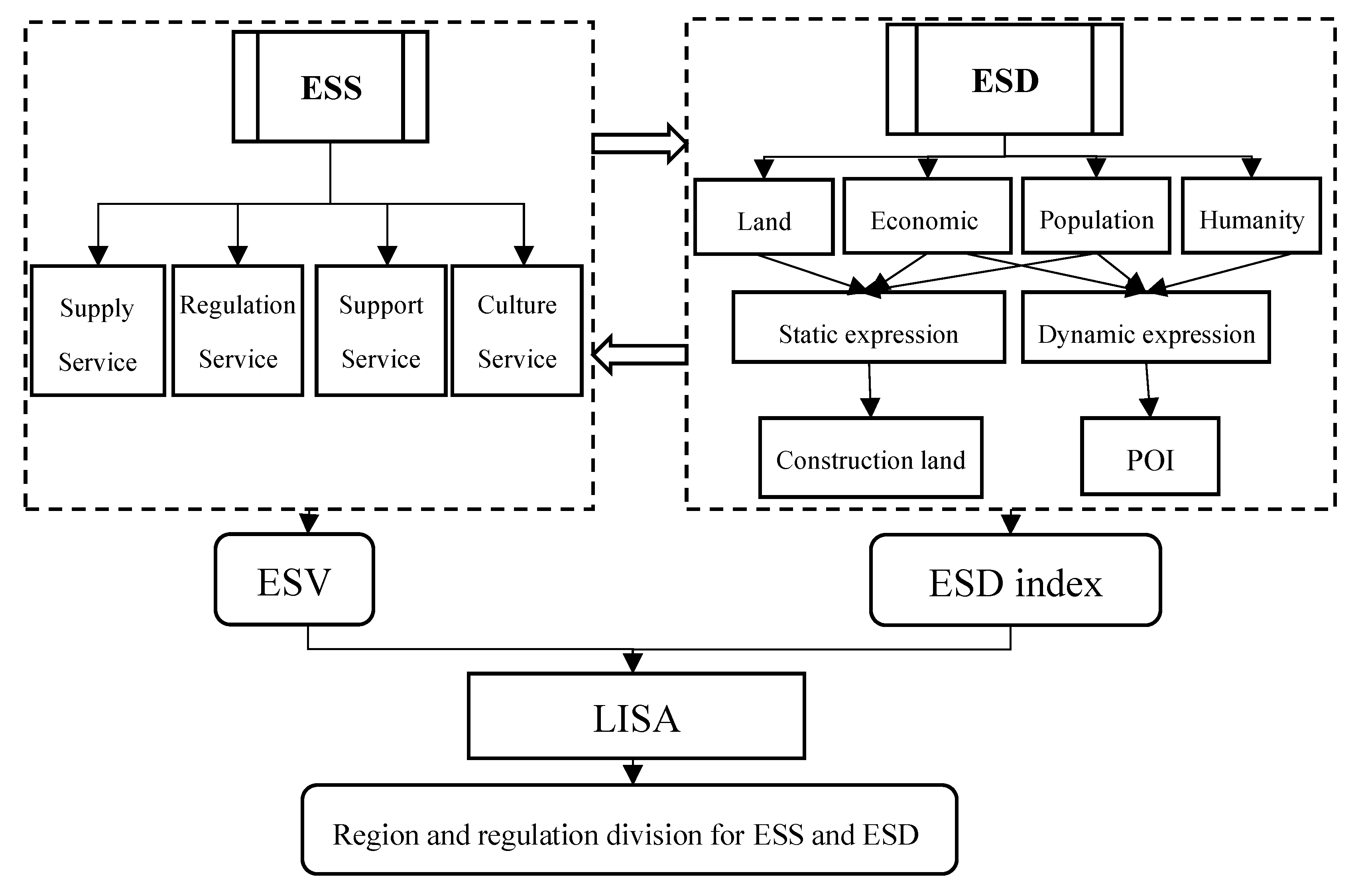
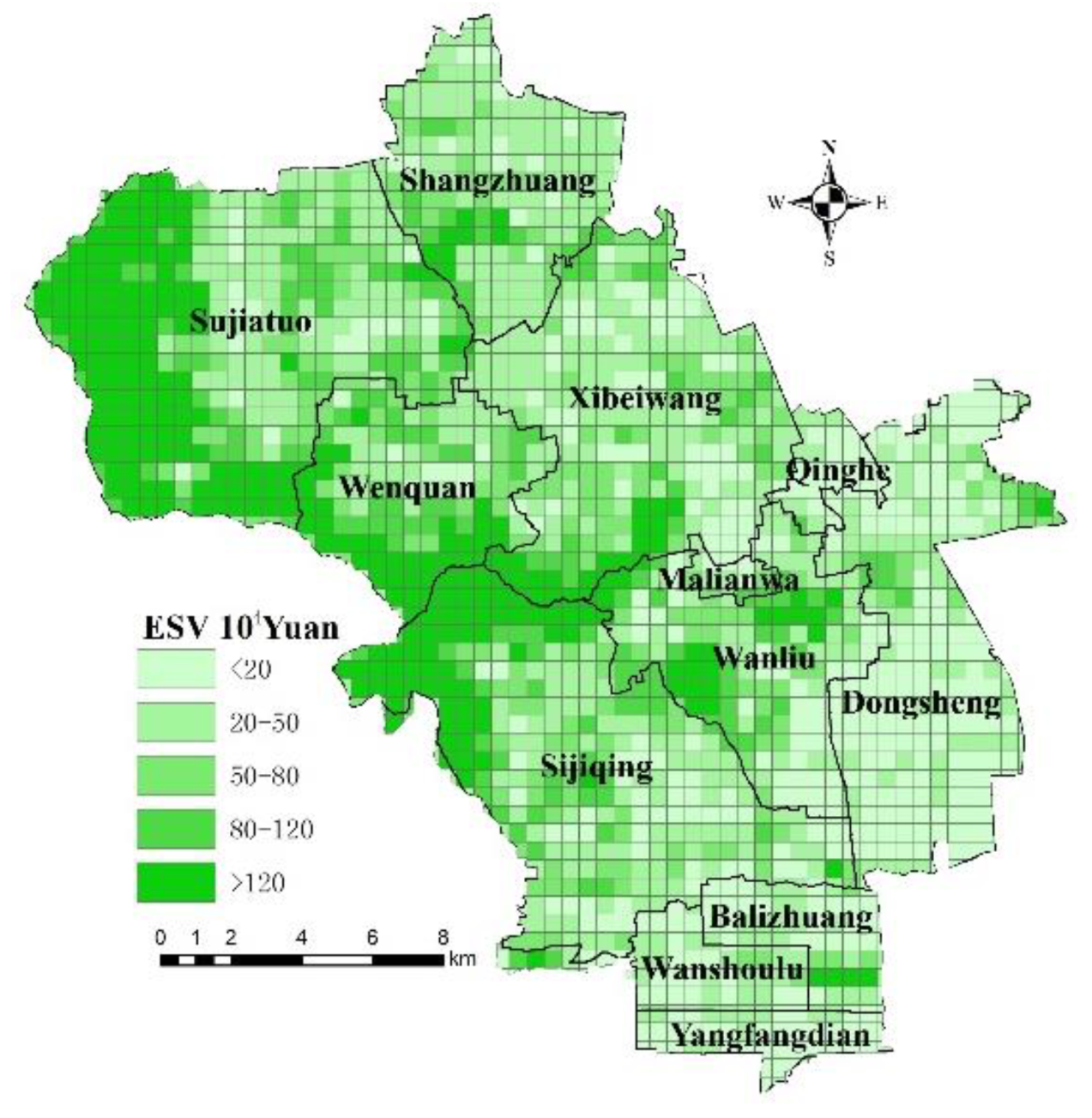


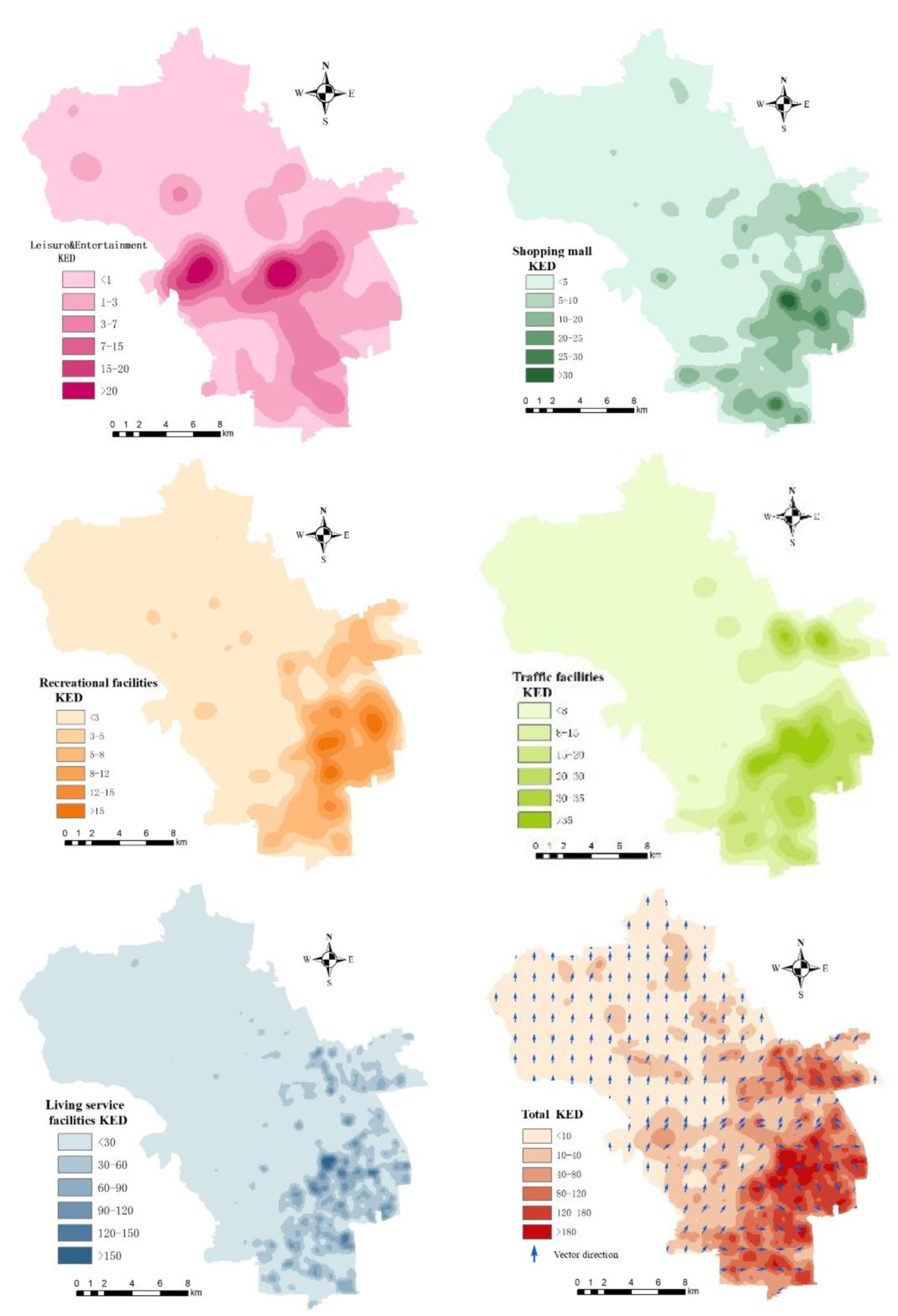
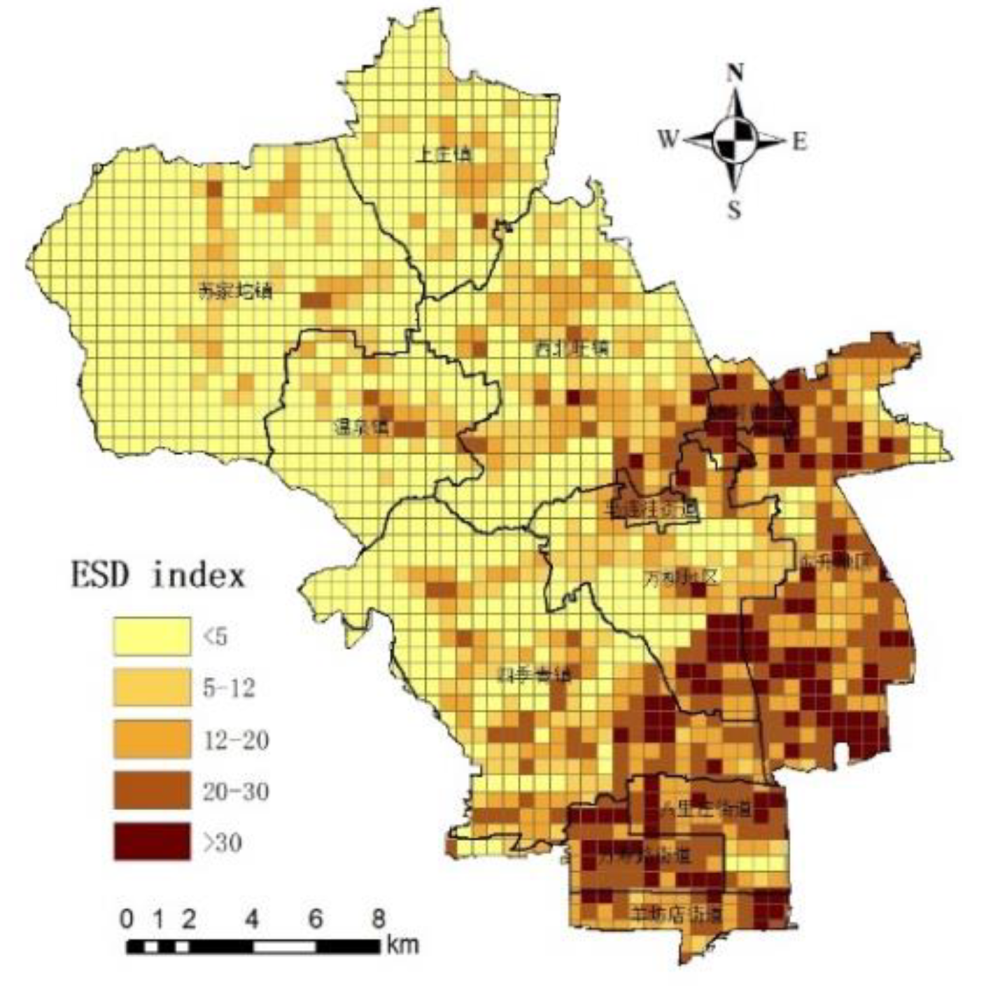
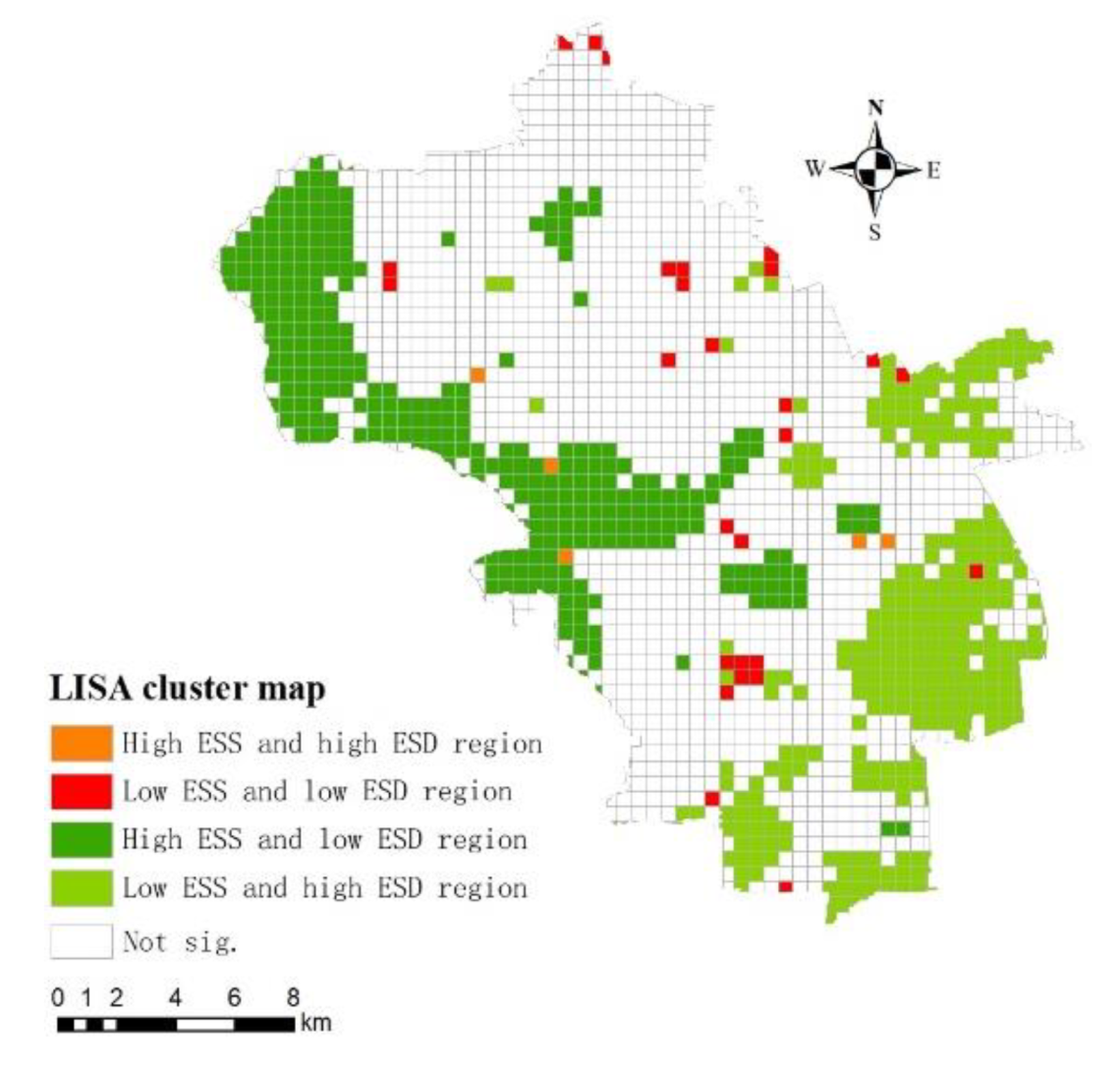
| Function | Sub Function | Forest Land | Cultivated Land | Water Body | Unused Land | Urban Green Space |
|---|---|---|---|---|---|---|
| Supply Service | Food Production | 457.98 | 2006.27 | 288.41 | 61.06 | 2019.45 |
| Raw Material Production | 4135.78 | 782.45 | 190.47 | 122.13 | 3566.94 | |
| Regulation Service | Gas Regulation | 9118.52 | 1519.75 | 1076.49 | 126.67 | 6142.34 |
| Climate Regulation | 8590.85 | 2047.46 | 4348.21 | 274.39 | 5941.83 | |
| Hydrologic Regulation | 8633.05 | 1625.31 | 39619.17 | 147.77 | 5920.71 | |
| Waste Treatment | 3630.52 | 2933.04 | 31344.96 | 548.82 | 3208.36 | |
| Support Service | Soil Maintenance | 8485.29 | 3102.85 | 865.41 | 358.85 | 6606.70 |
| Biodiversity Maintenance | 9519.57 | 2152.98 | 7239.93 | 844.31 | 6733.36 | |
| Culture Service | Provision of Aesthetic Landscape | 6352.08 | 519.18 | 13559.20 | 732.90 | 4504.49 |
| Total | 58,923.63 | 16,689.27 | 98,532.23 | 3216.89 | 44,644.17 |
| Type | Content | Quantity/Pcs. | Influence Scope/m |
|---|---|---|---|
| Catering and hotel facilities | Hotel and restaurant, etc. | 3542 | 800 |
| Traffic facilities | Expressway entry and exit, railway station, parking lot, etc. | 3237 | 1000 |
| Shopping malls | Shopping mall, supermarket, wholesale market, etc. | 1772 | 1200 |
| Living services facilities | Residential community, office building, bank, etc. | 5621 | 1000 |
| Cultural and educational facilities | University, primary and middle school, museum, street service center, etc. | 1134 | 1500 |
| Recreational facilities | Park, scenic spots and historical sites, cultural square, etc. | 891 | 1000 |
| Medical service facilities | Hospital, health station, large clinic, etc. | 497 | 1500 |
© 2020 by the authors. Licensee MDPI, Basel, Switzerland. This article is an open access article distributed under the terms and conditions of the Creative Commons Attribution (CC BY) license (http://creativecommons.org/licenses/by/4.0/).
Share and Cite
Tang, X.; Liu, Y.; Pan, Y. An Evaluation and Region Division Method for Ecosystem Service Supply and Demand Based on Land Use and POI Data. Sustainability 2020, 12, 2524. https://doi.org/10.3390/su12062524
Tang X, Liu Y, Pan Y. An Evaluation and Region Division Method for Ecosystem Service Supply and Demand Based on Land Use and POI Data. Sustainability. 2020; 12(6):2524. https://doi.org/10.3390/su12062524
Chicago/Turabian StyleTang, Xiumei, Yu Liu, and Yuchun Pan. 2020. "An Evaluation and Region Division Method for Ecosystem Service Supply and Demand Based on Land Use and POI Data" Sustainability 12, no. 6: 2524. https://doi.org/10.3390/su12062524
APA StyleTang, X., Liu, Y., & Pan, Y. (2020). An Evaluation and Region Division Method for Ecosystem Service Supply and Demand Based on Land Use and POI Data. Sustainability, 12(6), 2524. https://doi.org/10.3390/su12062524





